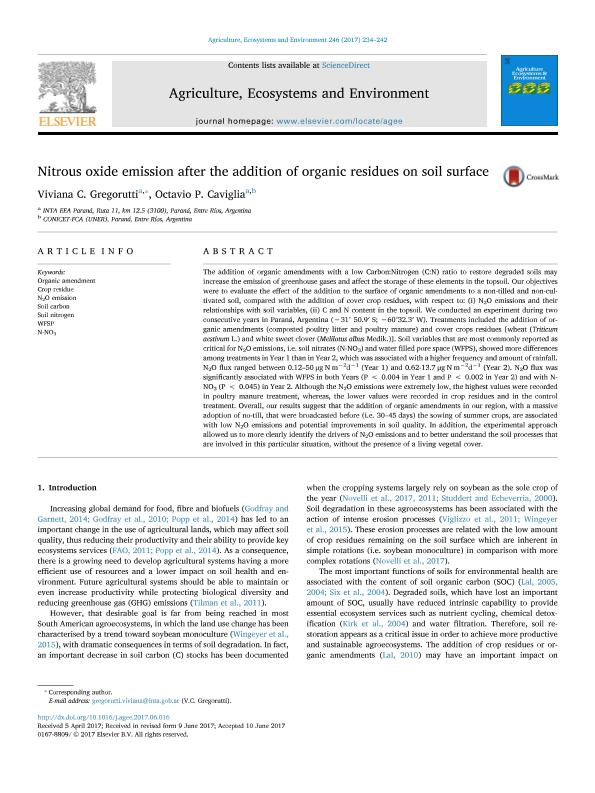Mostrar el registro sencillo del ítem
dc.contributor.author
Gregorutti, Viviana Carolina

dc.contributor.author
Caviglia, Octavio Pedro

dc.date.available
2019-03-26T17:54:17Z
dc.date.issued
2017-08
dc.identifier.citation
Gregorutti, Viviana Carolina; Caviglia, Octavio Pedro; Nitrous oxide emission after the addition of organic residues on soil surface; Elsevier Science; Agriculture, Ecosystems and Environment; 246; 8-2017; 234-242
dc.identifier.issn
0167-8809
dc.identifier.uri
http://hdl.handle.net/11336/72559
dc.description.abstract
The addition of organic amendments with a low Carbon:Nitrogen (C:N) ratio to restore degraded soils may increase the emission of greenhouse gases and affect the storage of these elements in the topsoil. Our objectives were to evaluate the effect of the addition to the surface of organic amendments to a non-tilled and non-cultivated soil, compared with the addition of cover crop residues, with respect to: (i) N2O emissions and their relationships with soil variables, (ii) C and N content in the topsoil. We conducted an experiment during two consecutive years in Paraná, Argentina (−31° 50.9′ S; −60°32.3′ W). Treatments included the addition of organic amendments (composted poultry litter and poultry manure) and cover crops residues [wheat (Triticum aestivum L.) and white sweet clover (Melilotus albus Medik.)]. Soil variables that are most commonly reported as critical for N2O emissions, i.e. soil nitrates (N-NO3) and water filled pore space (WFPS), showed more differences among treatments in Year 1 than in Year 2, which was associated with a higher frequency and amount of rainfall. N2O flux ranged between 0.12–50 μg N m−2d−1 (Year 1) and 0.62-13.7 μg N m−2d−1 (Year 2). N2O flux was significantly associated with WFPS in both Years (P < 0.004 in Year 1 and P < 0.002 in Year 2) and with N-NO3 (P < 0.045) in Year 2. Although the N2O emissions were extremely low, the highest values were recorded in poultry manure treatment, whereas, the lower values were recorded in crop residues and in the control treatment. Overall, our results suggest that the addition of organic amendments in our region, with a massive adoption of no-till, that were broadcasted before (i.e. 30–45 days) the sowing of summer crops, are associated with low N2O emissions and potential improvements in soil quality. In addition, the experimental approach allowed us to more clearly identify the drivers of N2O emissions and to better understand the soil processes that are involved in this particular situation, without the presence of a living vegetal cover.
dc.format
application/pdf
dc.language.iso
eng
dc.publisher
Elsevier Science

dc.rights
info:eu-repo/semantics/openAccess
dc.rights.uri
https://creativecommons.org/licenses/by-nc-nd/2.5/ar/
dc.subject
Crop Residue
dc.subject
N-No3
dc.subject
N2o Emission
dc.subject
Organic Amendment
dc.subject
Soil Carbon
dc.subject
Soil Nitrogen
dc.subject
Wfsp
dc.subject.classification
Agricultura

dc.subject.classification
Agricultura, Silvicultura y Pesca

dc.subject.classification
CIENCIAS AGRÍCOLAS

dc.title
Nitrous oxide emission after the addition of organic residues on soil surface
dc.type
info:eu-repo/semantics/article
dc.type
info:ar-repo/semantics/artículo
dc.type
info:eu-repo/semantics/publishedVersion
dc.date.updated
2019-03-26T13:51:55Z
dc.journal.volume
246
dc.journal.pagination
234-242
dc.journal.pais
Países Bajos

dc.journal.ciudad
Amsterdam
dc.description.fil
Fil: Gregorutti, Viviana Carolina. Instituto Nacional de Tecnología Agropecuaria. Centro Regional Entre Ríos. Estación Experimental Agropecuaria Paraná; Argentina
dc.description.fil
Fil: Caviglia, Octavio Pedro. Instituto Nacional de Tecnología Agropecuaria. Centro Regional Entre Ríos. Estación Experimental Agropecuaria Paraná; Argentina. Universidad Nacional de Entre Ríos; Argentina. Consejo Nacional de Investigaciones Científicas y Técnicas; Argentina
dc.journal.title
Agriculture, Ecosystems and Environment

dc.relation.alternativeid
info:eu-repo/semantics/altIdentifier/doi/http://dx.doi.org/10.1016/j.agee.2017.06.016
dc.relation.alternativeid
info:eu-repo/semantics/altIdentifier/url/https://www.sciencedirect.com/science/article/pii/S0167880917302591
Archivos asociados
